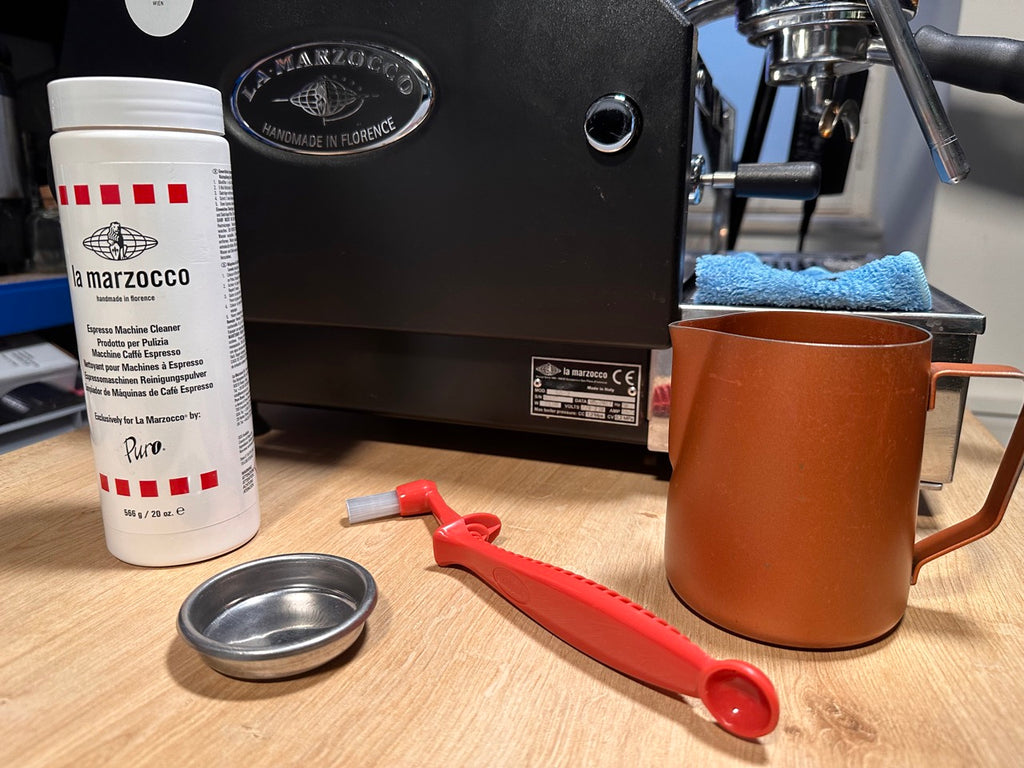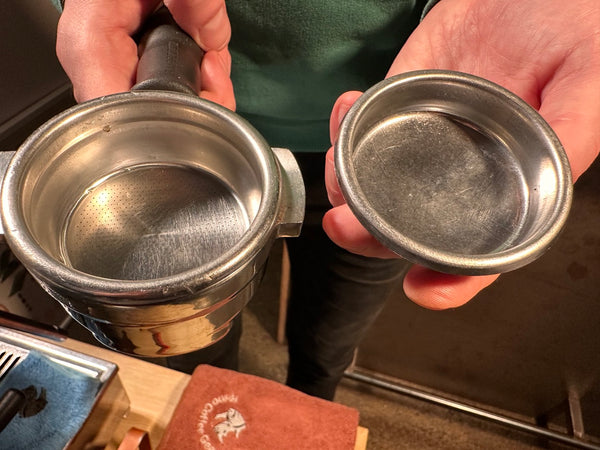Cleaning your coffee machine: The best tips for clean coffee enjoyment

Cleaning coffee machines simply explained
Cleaning the espresso machine
Cleaning a portafilter coffee machine isn't a daunting task, but it should be done regularly to avoid damage. In restaurants or offices (with more than 20 brews per day), cleaning is essential daily. Backflushing with a blind filter and cleaning agent is particularly important for the longevity of your coffee machine.
Before you start the backflushing process, you should clean the brewing head of any coffee grounds using a cleaning brush. You can also rinse the brewing head repeatedly with hot water. Then, replace the filter in the portafilter with a blind filter without holes. Now, pour a small amount of cleaning agent into the blind filter. The exact dosage is best found on the manufacturer's packaging.

Now, insert the portafilter into the brewing group and press the rinse button. The blind filter prevents water from draining, and pressure builds up in the espresso machine's lines. The hot water, combined with the cleaning agent and the pressure, ensures that the lines inside the coffee machine are cleaned.
You should backflush at least five times for about 10 seconds per brewing group. Some modern espresso machines have an automated cleaning program that automatically performs the number and duration of backflushes. In this case, simply follow the instructions on the coffee machine's display.

After backflushing all brewing groups with cleaning powder, rinse the portafilter with hot water. This removes any remaining cleaning agent from the blind filter. Then backflush each brewing group five more times using only water. Now you can be sure that no dirt or powder residue remains in the lines.
In addition to backflushing, you should also clean your coffee maker's steam wand. To do this, dilute some coffee cleaner with water in a milk jug and turn on the steam. Once this solution heats up, you can easily clean the steam wand of any milk residue. Make sure the steam nozzle isn't clogged. If it is, you can unscrew it and let it soak in the solution for a while. You can remove stubborn dirt with something like a toothpick.
From time to time, you should also clean the shower screen of your coffee machine's brewing group. This is usually only attached to the brewing group with a single screw. If the shower screen is heavily soiled, it negatively affects the water flow and thus the extraction. This often also affects the crema! It's best to clean the shower screen with a soft sponge and a diluted coffee machine cleaner.
With all these cleanings, you'll protect your coffee machine from dirt buildup in the pipes and boilers. Don't wait too long to clean your espresso machine, or you could incur high repair costs or render the machine unusable!
Cleaning the filter coffee machine
Cleaning and maintaining your filter coffee machine is quite simple. Regular descaling is especially important. Limescale deposits can affect the taste and functionality of your filter coffee machine. Some coffee machines already have their own cleaning and descaling programs that guide you through the entire process. Also, refer to your machine's manual; sometimes the manufacturer recommends specific processes or procedures for your machine. If this isn't the case with your filter coffee machine, you can clean it as follows.

To descale your filter coffee machine, you only need a descaling agent (liquid or powder) and water. Simply dilute the manufacturer's recommended amount of descaling agent with water and pour this mixture into the water tank of your filter coffee machine. To remove limescale residue more easily, we recommend using a paper filter during the cleaning process. Now, turn on the coffee machine as usual and wait until some of the liquid has run through. You can then turn off the machine and let the solution work for 10-15 minutes. Then, turn the coffee machine back on and stop the brewing process.
After all the liquid has run through, you should brew two or three more times with clean water. This will remove any limescale and solution residue.
We advise against using vinegar cleaners or citric acid to descale or clean your coffee maker. After all, a harsh vinegar solution can damage your machine's pipes and seals. Heating citric acid above 60°C produces calcium citrate, which, if left to settle, can cause significant damage to your coffee maker. Both household remedies also emit a strong odor that can permanently impair your coffee experience.
Cleaning the fully automatic coffee machine
Cleaning fully automatic coffee machines is usually child's play. An indicator on the coffee machine tells you when it's time to run the cleaning or descaling program again. Most manufacturers recommend specific cleaning agents, but in principle, you can also use other products suitable for fully automatic coffee machines.
Cleaning the brewing chamber and pipes is often easier with cleaning capsules. You can find out where to insert these in your coffee machine's manual. How often you need to clean your coffee machine depends on the type and frequency of your coffees. If you also prepare latte macchiatos with your fully automatic machine, a separate cleaning of these pipes may be necessary, according to the manufacturer's instructions.
To descale your fully automatic coffee machine, it's best to use a liquid descaling agent. Mix this with water, as directed on the package, and pour it into the water tank of your coffee machine. Then start the descaling program and follow the instructions on the display. Please note that both the cleaning and descaling programs take some time. You won't be able to use the coffee machine during this time. Monday morning at the office is definitely out of the question.
Cleaning the capsule machine
A quick look at your capsule machine's manual is worthwhile, but cleaning is largely limited to descaling the coffee machine. After all, your capsule or pod machine only comes into contact with ground coffee to a very limited extent. The principle is usually the same: Mix the descaling agent with water, fill the tank, and empty the entire solution. Then rinse the capsule machine with two or three tankfuls of clean water.

Leave a comment